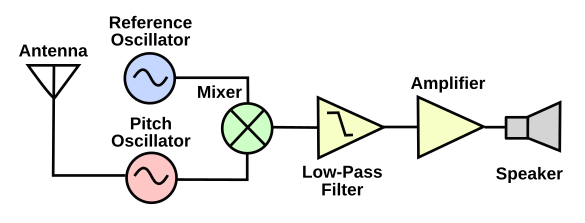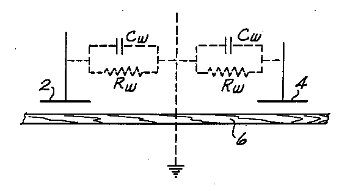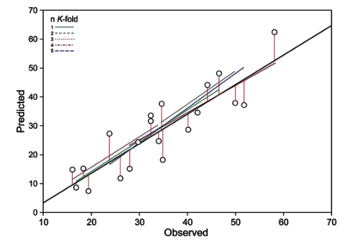Capacitance Sensing
December 5, 2016
Most people have heard the sound of a
Theremin, an
electronic musical instrument invented by
Russian physicist and
electrical engineer,
Léon Theremin. Members of
my generation will know its sound from "
Good Vibrations," the 1966
record by
The Beach Boys. The instrument used in "Good Vibrations," the
Electro-Theremin, was not an actual Theremin, but an
electronic circuit that simulated the sound of a Theremin. Theremin sounds were the staple of many early
science fiction film soundtracks.
While Léon Theremin needed
vacuum tubes to create his circuit, a Theremin is easy to build using modern electronic components, and I built one myself many years ago. A Theremin is essentially an
oscillator that has its
tank circuit (the
inductance-
capacitance combination that sets its
frequency) connected to an
antenna. The signal from that oscillator is mixed with that of another oscillator to produce a
tone that's the difference of the two oscillator frequencies. When the oscillators are tuned to the same frequency, then the tone is
inaudible, since the difference is zero frequency.

Block diagram of a simple Theremin. When building one of these, it's important to realize that the oscillator that's connected to the antenna must be low power and oscillates in only certain frequency bands; otherwise, the circuit will generate radio frequency interference. (Wikimedia Commons image, drawn by the author using Inkscape.)
When an object like a
human hand is brought close to the antenna, the capacitance of its tank circuit is slightly changed, so the oscillator frequency is changed, and a tone will appear in the
audio frequency range. Careful placement of a hand will produce a precise
musical tone, just as when a
violinist moves her hand on an
unfretted violin string to produce a
note.
Capacitance change from the proximity of a
human finger is the basis of the
capacitive sensing technology used in the
touchscreens of many electronic devices. While it's often easier to use a
stylus with smaller screens, a special,
conductive stylus is needed to activate touch on a capacitive screen. A standard stylus doesn't work, nor does the touch of a
gloved hand.
Going back to basics is often beneficial when exploiting a technology, and this was true in the early days of capacitive sensing. Just as the region influenced by a
magnet can be
visualized by magnetic
field lines, the same is true for a capacitor and
electrical field lines. In a
parallel plate capacitor, these field lines are concentrated between the plates, with just a few
fringe field lines accessing a region where a body might be sensed.
One trick to "focus" the field lines towards an external body is to interject a
driven shield; that is, another conductive plate inside the parallel plate capacitor that's electronically driven to have the same
potential as the sensing plate (see figure). Since the potentials of the driven shield and the sensing plate are the same, there can be no field lines between them, so most of the field lines are concentrated in the region near the body to be sensed. This idea is incorporated into an early
NASA patent,[1] and I published a simple circuit for a capacitive sensor based on this idea several years ago.[2]

The driven shield concept as applied to a capacitive sensor. A sensor plate (p) without a driven shield (s), as shown on the left, has few field lines available for sensing. A driven shield, as shown on the right, forces the field lines into the sensing region. (Drawn using Inkscape.)
Since capacitance is a
linear function of the
relative permittivity (often called the
dielectric constant) of a
material, capacitance is often used to assess a material's
composition, especially its
water content. Water has a huge relative permittivity, about 80 at
room temperature, at frequencies below a
gigahertz, so its contribution to capacitance is large. Capacitance is used to sense the moisture content in such things as
grains and
wood.[3-6]

Equivalent circuit of a lumber sample as seen by measuring electrodes.
(Fig. 4 of ref. 6, via Google Patents.)
Botanists at
Cornell University's New York State Agricultural Experiment Station,
Geneva, New York, have recently investigated the use of capacitance sensing as a means to assess the
dry weight of
roots of various
hybrids of the
shrub willow, Salix.[7-8] Because of its rapid growth rate, this
species has become an important source of
biofuel, as a
soil erosion preventative, for
carbon sequestration, and for
phytoremediation.
The Cornell
research team was faced with the problem of how to assess the root
biomass of many hundreds of
potted plants to select individual plants for further
breeding experiments. The conventional method is to mechanically remove the soil by washing, then
drying and
weighing the root
tissues, a destructive and time consuming task.[8] Capacitance has been used to measure root biomass in the past on
hydroponically grown plants, and the Cornell team decided to try this technique on their soil-grown plants.[8]
Says
Craig Carlson, a Cornell University
PhD candidate and an
author of the study,
"A majority of electroconductivity studies have focused on annual grasses and hydroponic systems. We wanted to develop a cheap, quick method of measuring root biomass in soils."[8]
In a typical
scenario, individuals are
propagated from
cuttings, and then cut down to the
stump, leaving the root system intact.[8] This allows regrowth from the original
rootstock, the biofuel harvesting occurs every three years, and such cycles can persist for more than twenty years.[8] Assessment of the original rootstock is important to attain a quality
crop over such a long period.[8]
The measurement setup consisted of a
stem clamp, soil
probe, and a capacitance meter.[8] The measured capacitance was in the range of about 150
nanofarads.[7] There was a strong linear
correlation between the measured capacitance and root dry biomass, with a
correlation coefficient, r = 0.88.[7]

Root biomass correlation from capacitance measurements.
The R2 value of the linear fit is 0.77.
(Fig. 2 of ref. 7, licensed under a Creative Commons Attribution License (CC-BY-NC-SA).)
Says Carlson's co-author, Cornell's
Larry Smart,
"Craig's method allows us to select new cultivars that could be more drought tolerant or be able to occupy marginal sites, such as reclaimed mine sites in West Virginia... This method could be directly applied to breeding programs for crops that generally require grafting to rootstocks to maintain scion varieties... Our next step is to take this method into the field and see if these correlations hold up."[8]
References:
- John M. Vranish and Robert L. McConnell, "Driven shielding capacitive proximity sensor, US Patent No. 5,166,679, November 24, 1992.
- Dev Gualtieri, "Driven Shield Enables Large-Area Capacitive Sensor," Electronic Design, January 15, 2013.
- Mark E. Casada and Paul A. Armstrong, "Wheat Moisture Measurement with a Fringing Field Capacitive Sensor, American Society of Agricultural and Biological Engineers Annual International Meeting (Providence, Rhode Island, June 29 - July 2, 2008).
- Hongxia Zhang, Wei Liu, Boxue Tan, and Wenling Lu, "Corn Moisture Measurement using a Capacitive Sensor," Journal Of Computers, vol. 8, no. 6 (June, 2013), pp. 1627-1631.
- William S. Bessa, Eduardo P. Ribeiro, Marlio C. Bonfim, Gideon V. Leandro, and Marcelo R. Errera, "Analysis of capacitive measurements at low frequencies for moisture content determination in soybeans," Brazilian Journal Of Instrumentation And Control November (2013), pp. 29-34, DOI: 10.3895/S2318-45312013000100005.
- Robert S. Parker and Frank C. Beall, "Method of measuring moisture content of dielectric materials," US Patent No. 4,580,233, April 1, 1986.
- Craig H. Carlson and Lawrence B. Smart, "Electrical capacitance as a predictor of root dry weight in shrub willow (Salix; Salicaceae) parents and progeny," Applications in Plant Sciences, vol. 4, no. 8 (August 19, 2016), Document no. 1600031, doi: http://dx.doi.org/10.3732/apps.1600031.
- Getting to the root of it: Predicting root biomass with electrical capacitance, Botanical Society of America Press Release, November 7, 2016.
Permanent Link to this article
Linked Keywords: Theremin; electronic musical instrument; Russia; Russian; physicist; electrical engineer; Léon Theremin; baby boomer; my generation; Good Vibrations; record; The Beach Boys; Electro-Theremin; electronic circuit; science fiction film; soundtrack; vacuum tube; electronic oscillator; LC circuit; tank circuit; inductance; capacitance; frequency; antenna; pitch; tone; sound; audible; block diagram; power; frequency band; radio frequency interference; Wikimedia Commons; Inkscape; human hand; audio frequency; musical tone; violin; violinist; fret; violin string; human finger; capacitive sensing; technology; touchscreen; stylus; electrical conductor; conductive; glove; magnet; scientific visualization; visualize; field line; electric field; parallel plate capacitor; fringe; driven guard; driven shield; electric potential; NASA; patent; linearity; linear; function; relative permittivity; dielectric constant; material; chemical compound; composition; water; room temperature; hertz; gigahertz; food grain; wood; equivalent circuit; lumber; electrode; Google Patents; botany; botanist; Cornell University; New York State Agricultural Experiment Station; Geneva, New York; dry matter; dry weight; root; hybrids; shrub willow, Salix; species; biofuel; soil; erosion; carbon sequestration; phytoremediation; research; biomass; potted plant; selective breeding; experiment; drying; analytical balance; weighing; tissue; hydroponics; Craig Carlson; PhD candidate; author; electroconductivity; poa annua; annual grass; scenario; plant propagation; propagate; cutting; stump; rootstock; crop; plant stem; clamp; probe; nanofarad; correlation; correlation coefficient; linear regression; linear fit; Creative Commons Attribution License (CC-BY-NC-SA); Larry Smart; cultivar; drought; mine; West Virginia; grafting; graft; scion; John M. Vranish and Robert L. McConnell, "Driven shielding capacitive proximity sensor, US Patent No. 5,166,679, November 24, 1992; Robert S. Parker and Frank C. Beall, "Method of measuring moisture content of dielectric materials," US Patent No. 4,580,233, April 1, 1986.